| |
|

Friday, July 11 Congregation Beth El Kabbalat Shabbat Services


FRIDAY, JULY 18 Temple Solel Shabbat at Beach
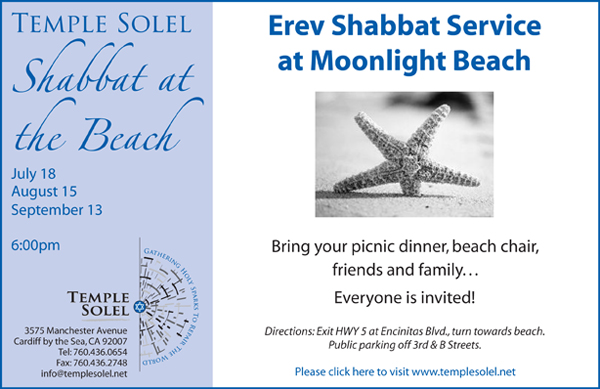



THE VIEW FROM JINSA
Murtha owes Marines an apology
By Shoshana Bryen
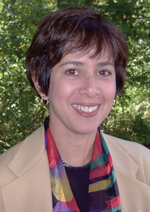 WASHINGTON, D.C.—Of the eight Marines charged in connection with the battle of Haditha, six have had all charges dropped and one has been exonerated in a military court. The last Marine remains to face charges related to the handling of the incident. In our experience, Marines - including retired Marines - do the right thing. So we expect John Murtha to issue a serious, responsibility-taking apology to the eight Marines he publicly defamed following the battle. We expect it to look like this: WASHINGTON, D.C.—Of the eight Marines charged in connection with the battle of Haditha, six have had all charges dropped and one has been exonerated in a military court. The last Marine remains to face charges related to the handling of the incident. In our experience, Marines - including retired Marines - do the right thing. So we expect John Murtha to issue a serious, responsibility-taking apology to the eight Marines he publicly defamed following the battle. We expect it to look like this:
I am sorry. I accused United States Marines in a wartime situation of "cold blooded murder" that I said was "worse than My Lai." This was wrong at many levels and I want to be clear that I understand how grievously I erred at the expense of these Marines and the reputation of the Marine Corps.
I was running for office and I allowed myself to be swayed by media reports of what happened in Haditha. Where I should have maintained skepticism of the media and faith in the Marines, I did the opposite. Where I should have drawn on my own knowledge and experience in battle, I read accounts told to a reporter with no combat experience by a source from the Iraqi insurgency. I apologize for that mistake and for my lack of faith in American Marines.
I was and remain an opponent of the war in Iraq as it evolved after I voted with 80 of my Democratic colleagues to authorize the use of force. I allowed my opposition to President Bush and to the war to influence my view of the soldiers fighting it. I believed that if American soldiers had committed crimes against Iraqi civilians, Democrats could hold the President personally responsible and thus further erode the support of the American people for the President and for his policies. I apologize for using these Marines and the reputation of the Marine Corps for partisan political ends.
My words had the effect of undermining respect and support for the Marines, and by extension support for all American service men and women. I apologize to all of them.
This week the Supreme Court erased precedent from previous wars about the handling of enemy combatants; the Court erased the carefully crafted compromise between the Executive and Legislative Branches of our government for handling enemy combatants; and the Court arrogated to unelected judges the right to determine by lawsuit what had already been determined by statute. I did something worse. Violating a fundamental pillar of American justice, I presumed guilt instead of innocence and I did it publicly. I apologize for that to these Marines and to the Marine Corps.
The Marines have a saying: "To err is human, to forgive is Divine; neither is Marine Corps policy." I do not know whether the Marines at issue or the Marine Corps as an institution will forgive what a retired Marine has done. I can ask for forgiveness, but it isn't for me to say that I deserve it. It is my obligation, however, to acknowledge that I was wrong, to say I am profoundly sorry and to say I will do my best never to put the Marine Corps or myself in such a position again."



ARTS IN REVIEW
S.D. weighs festival of new Jewish plays
By Carol Davis
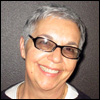 SAN DIEGO—The first Annual Festival of New Jewish Plays? That’s what being touted in the lineup of the current 15th Annual Lipinsky Family Jewish Arts Festival taking place at the San Diego Repertory Theatre downtown, at The Old Globe in Balboa Park and at the North Coast Repertory Theatre in Solana Beach. But for those of us who have been around for longer than we’d like to admit, there was the Streisand Festival of New Jewish Plays that date back to the early 80’s. And I was there covering them. SAN DIEGO—The first Annual Festival of New Jewish Plays? That’s what being touted in the lineup of the current 15th Annual Lipinsky Family Jewish Arts Festival taking place at the San Diego Repertory Theatre downtown, at The Old Globe in Balboa Park and at the North Coast Repertory Theatre in Solana Beach. But for those of us who have been around for longer than we’d like to admit, there was the Streisand Festival of New Jewish Plays that date back to the early 80’s. And I was there covering them.
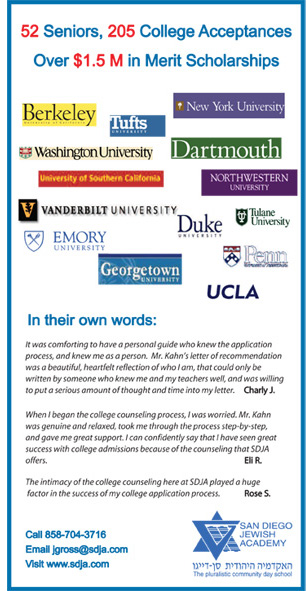 If we’re splitting hairs, the Streisand Festival came before the Lipinsky Jewish Art Festival and mounted some very fine new works including plays and dance presentations, particularly those of our own John Malashock and Gina Angelique and her Evoke Dance Company. So, maybe not! In 2002, towards the conclusion of the 21-year festival, four new plays were presented at the Lawrence Family Jewish Community Center in La Jolla. In a brief conversation with Judith Friedel, who headed up the Streisand Festival for many years, “The money ran out” she said in passing when asked what ever became of it. If we’re splitting hairs, the Streisand Festival came before the Lipinsky Jewish Art Festival and mounted some very fine new works including plays and dance presentations, particularly those of our own John Malashock and Gina Angelique and her Evoke Dance Company. So, maybe not! In 2002, towards the conclusion of the 21-year festival, four new plays were presented at the Lawrence Family Jewish Community Center in La Jolla. In a brief conversation with Judith Friedel, who headed up the Streisand Festival for many years, “The money ran out” she said in passing when asked what ever became of it.
That said, the Streisand Festival is gone and now hopefully, the Lipinsky Jewish Art Festival will pick up the baton and more and more Jewish themed plays will make it past the stage reading phases. This year, two new plays emerged, one that had already been mounted in two venues in two different states and one so fresh off the writing tablets that the playwrights have yet to determine which of the many endings to use. Both plays were mounted at The North Coast repertory Theatre and played to very sophisticated audiences who were more than willing to provide feeback to the actors, as well as with Todd Salovey, artistic director of The Festival and Steve Lipinsky, who directed both readings.
Both plays are about family, religion and relationships; all volatile subjects when put in positions of compromise. Both plays are what might be billed as comedies and are funny in a stereotypically predictable way. Both divert, stray and take off in directions that are at odds with what they appear to be. Neither completely satisfied the viewers in attendance each evening, with some more critical than others. Both have volumes to say, to be rewritten (if that’s the case) to be redirected and to becoming more faithful (no pun intended) to their original premise.
In Janece Shaffer’s Bluish, the conflict comes in when Ben’s soon-to-be wife, Beth learns that she has ‘Jewish’ blood in her ancestral genes, her mother to be exact, and decides to become an Observant Jew (note observant with a capital ‘O’) even before they are married, much to the chagrin of Ben but to the joy of his parents, Manny and Lillian. Beth goes about learning all she can on the subject, customs and practices of Ben’s Judaism with the enthusiasm of one who has just unearthed a lost treasure. Ben, on the other hand, is as chagrined as Beth is overzealous.
Ben, who considers himself a Jew as in Jewish, well kind of as in blue as a kind of bluish, was not ready for this development. Ben, who was relieved to be getting married to a non Jew and out of his parents' Jewish home was more than happy not to have to even think of this as an issue. As an up and coming TV news anchor, he never let his religion get in the way of his career choices, which included covering the news on the weekends.
He was more of a philosophical Jew than a religious Jew. And the topping on the cake with Beth was the fact that Beth was so non Jewish in every way, her choice of college sorority, her looks and her unyielding support for his work, it never occurred to him there would be conflict about this. She was the Grace Kelly look-a-like every Jewish boy supposedly wanted to marry and neither of their religions came into the picture.
Filled with all the right witticisms, arguments and reasons for them not to be as observant as Beth would like, Ben sees Beth slowly winning this battle, big time. She goes to temple with his father, she lights the candles, turns down Friday night outings, etc.
Ben changes from a loving, gentle and caring fiancé to an angry young man deeply in love but at a crossroads. The conflict is real and needs resolution but Shaffer turns a very funny situational comedy into a serious piece that ends on an unsatisfactory note showing Ben’s submitting to Beth in a ‘they all lived happily ever after’ ending, that happens so fast the audiences don’t have time to digest the change. As the gentleman sitting next to me visiting from Las Cruces, NM muttered, “She’s trying to change him too fast.” That about sums it all up from a male perspective.
Matt Thompson’s The Wondering Jew is hot off the press so much so that the ending chosen for this production was one of many. Again, in this conflict of ‘whose religion is it anyway?’ David’s soon to be live- in girlfriend Maritza, is not only Catholic but comes from a large immigrant family of Cuban ancestry. When Maritza and her family— mom, dad and sister— are invited to David’s home for Passover, well, let’s say it’s a perfect set up for a great comedy.
Something happens, however, from the time David’s family arrives to cook the brisket until the said dinner gets burnt in the oven while both families try to sort out how the couple (who are not yet married or engaged for that matter) will bring up the kids.
With both sets of parents to contend with and an ocean dividing the respective religions, perceptions and beliefs and with sharks circling the couple, Thompson’s play takes off into uncharted waters. The first act is funny, amusing and sharp but the second act takes a turn toward the not-so funny with a whole new set of problems to sort out. It’s another play for another time.
Once again, a terrific idea for a comedy strays, gets muddy and bogged down with philosophical dialogue that, frankly, is too much overkill for this little slice of Jewish humor. Thompson has great ear for comedy and his dialogue and characters are real on many different levels. Some of the situations are a little out of sync, but rewriting and a closer examination of Jewish customs (as in the youngest child doesn’t hide the Matzo, he or she finds it) will fix that; an oversight, I’m sure.
And while I’m not a playwright by any stretch of the imagination, I saw a whole other play unfolding about the customs and practices of Passover playing out to a family as alien to the idea as if they had just landed from Mars. Had Matt chosen this route to take and run with it, he would have had a great family comedy on his hands and possibly a lesson or two on tolerance, understand and family values; something to take home for the modern young interfaith couples, and those families less open-minded to change, along with a string of Matzo jokes to soften the blow. Well?
It’s been a while since yours truly has been to play readings and I forgot how much insight one gets into the process of mounting a new play and how much talent is sitting out there. Kudos to both of the playwrights, the director and the talented cast who, from my understanding had very little time to rehearse. Hopefully this will truly be the first of many to come.
The Festival continues Mon. the 23rd at the San Diego Rep. downtown with “A Musical Tour Of the Jewish Calendar” and on the 30th with the “8th Annual Klezmer Summit”.
See you at the theatre.

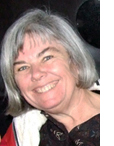 Nancy Harrison Nancy Harrison
cruise & tour specialist
(619) 265-0808

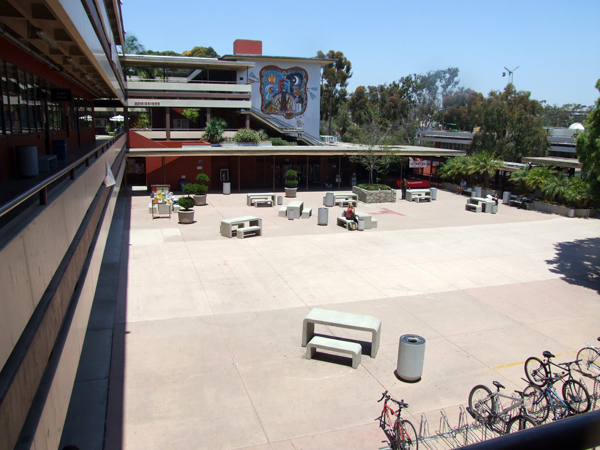
THE JEWISH CITIZEN
Garden and square memorialize 2 favorite
professors at San Diego City College
By Donald H. Harrison
 SAN DIEGO—In my continuing quest to get exercise while finding a Jewish story, I went with walking companion Dan Schaffer a few days ago to the 60-acre San Diego City College. How long would it take to find a Jewish story? I wondered. Dan had an amused expression on his face, but said nothing. SAN DIEGO—In my continuing quest to get exercise while finding a Jewish story, I went with walking companion Dan Schaffer a few days ago to the 60-acre San Diego City College. How long would it take to find a Jewish story? I wondered. Dan had an amused expression on his face, but said nothing.
We walked several blocks to the 16,000-student campus from an area where street parking is free near Broadway and 19th Street. Arriving at Curran Plaza, named for a jolly former mayor of San Diego—Frank Curran—we found a map of the campus, and I had to laugh. “Oh this is too easy, “I exulted.
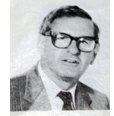 Just a short distance away was a place identified on the map as "Schwartz Square,"
where, after a while, we found an exterior wall-mounted plaque explaining that it was named “in memory of Larry Schwartz. He inspired students, challenged colleagues and shared the passion and action of his time.” The plaque also gave Schwartz’s birth date of Dec. 9, 1932, and death date of Feb 7, 1995. A photo from an old faculty directory is reprinted at right. Just a short distance away was a place identified on the map as "Schwartz Square,"
where, after a while, we found an exterior wall-mounted plaque explaining that it was named “in memory of Larry Schwartz. He inspired students, challenged colleagues and shared the passion and action of his time.” The plaque also gave Schwartz’s birth date of Dec. 9, 1932, and death date of Feb 7, 1995. A photo from an old faculty directory is reprinted at right.
I didn’t have to inquire whether Larry Schwartz was Jewish because I remembered him well as both a political activist and a leader in the local chapter of the American Federation of Teachers. During the 1970s, when I covered politics for the morning San Diego Union, I often ran into Larry and his wife Rosalie while covering this meeting or that.
Learning that I was a fellow Jew, the Brooklyn-born Schwartz wanted to know if my family name had been changed. I confirmed that it had been changed in 1909 when my grandfather who had just become an architect in New York City decided that doing business under the name M. Joseph Harrison might prove more lucrative than under his name of Meyer J. Harowitz. So he changed his name, and persuaded his father, Velvel, to do likewise. Velvel became William. And my own father, Martin, was born as a Harrison in 1910.
I understand that “witz” means “son” in various languages, so there was logic in Harawitz becoming Harrison. The fact that two U.S. Presidents and a signer of the Declaration of Independence had been named “Harrison” may also have been a factor in the family’s name choice.
After hearing that story, Larry never failed to greet me with both names. “Hey, Harrison Harawitz,” he’d call out.
Asking around the San Diego City College campus about Schwartz, we learned that he not only was a popular teacher but that he had helped to organize the teachers for the AFT and had been a president of that union.
Rosalie later told me that Larry was simultaneously loved and quite controversial, because he was an ardent campaigner for many causes about which he felt strongly. He was for Civil Rights, against the War in Vietnam, and ever ready to take up the cudgels against the administration if ever it dared to prohibit a student from leafleting for a political cause or posting signs on campus billboards.
The wording of the plaque was inspired by a famous quote of Justice Oliver Wendell Holmes: “Life is action and passion; therefore, it is required of a man that he should share the passion and action of the time, at peril of being judged not to have lived.”
When it came to First Amendment freedoms, particularly free speech, Schwartz was a passionate activist, so when it was decided to name something for him, there could be no better spot than the previously unnamed courtyard that had served as City College’s free speech area.
Schwartz, who taught history, probably would have been proud if he could have read the various flyers that one could find on the campus the day we visited. There were solicitations for the Krishna Lounge in Pacific Beach, for bible study with the Inter-varsity Christian Fellowship, and an announcement of a town hall meeting to be conducted that very evening on campus by the Workers World Party featuring its 2000 U.S. presidential candidate Monica Moorehead. Appearing with her were such other speakers as Martha Rojas of the May Day Unity Coalition of Los Angeles; Carl Muhammad, described as an anti-police brutality activist, and Gloria Verdieu of the San Diego Mumia Coalition. The latter is a group of people who believe that former Black Panther Mumia Abu-Jamal is wrongly on death row in a Pennsylvania State Prison.
One can imagine Schwartz beaming; this group might have reminded him of the heyday of college activism in the 1960s and 1970s. He probably also loved the large mural that had graced the square even before it was named for him. Carol Dexheimer, a San Diego City college vice president, went through her archives of materials about the college’s physical features, and found a brief description of the Aztec-inspired mural, which had been titled Nuestra Vida Chicano (Our Chicano Life).
It read: “Life springs from the bronze trunk of the ‘arbol de la vida.’ Man’s head, dressed in an ancient Indian helmet, represents the highest order of life. Above it is another Indian symbol—eternity. The tree trunk has a navel (a profile of an eagle’s head) which further joins “ man with nature. The eagle is a symbol of Chicano power in the same stead.
“Light dominates the left side of darkness, darkness the right side of light. Thus, duality is evident in the mural concept: Quetzalcoatl, the god of light, is supported by the sun; Taxcallipoca, smoking mirror of night, is supported by the moon. The day god is a plumed serpent; the night god is a jaguar. Finally, there are buildings in contrast with the temple—European versus indigenous, old and new.
“The entire mural is framed by a serpent—Quetzalcoatl, who in Mexican folklore bled his member upon the bones of the dead to produce the new man, the final man of El Quinto Sol (the fifth and last sun world.) Thus man and his world are surrounded by the creator of the Nuestra Vida Chicano.”
 So, had Dan Schaffer known about Larry Schwartz all along? Was that the reason for his amused expression? So, had Dan Schaffer known about Larry Schwartz all along? Was that the reason for his amused expression?
No. It turned out that he had another card up his sleeve: He was well aware that the “Sid’s Garden” (at right) located next to City College’s Learning Resource Center had been named for Sidney H. Forman. The Learning Resource Center, which houses the library, was partially designed by Forman, who set up the computer learning labs housed within.
Schaffer had known Sid Forman and his wife Pauline from the Saturday morning Torah study class led by Rabbi Martin S. Lawson at Temple Emanu-El. Occasionally Pauline joins Dan, Shimon Camiel, and other walkers on treks around Lake Murray.
“Sid’s Garden” was named while Forman was fighting pancreatic cancer to indicate to this man, who had taught at SDCC for 46 years, how well loved he was. He had taught English, photography, film history and film production and on the side photographed hundreds of weddings and bar mitzvahs. He had bachelor’s and master’s degrees in English and linguistics from the University of Michigan and received a Rockefeller grant for advanced linguistics study.
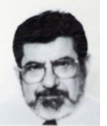 The plaque, set onto the garden grounds,reads: "Sid's Garden—In honor of Sid Forman's service and commitment to City College for over 46 years." The plaque, set onto the garden grounds,reads: "Sid's Garden—In honor of Sid Forman's service and commitment to City College for over 46 years."
So why a garden? In the last five months of his life, when Forman was too ill to come into work, he nevertheless remembered his non-Jewish colleagues at Christmas time by sending four large poinsettia plants for the offices. When school vacation approached, the colleagues tried to determine who should take the plants home to care for them. During this discussion, someone suggested that the plants should be
planted alongside the Learning Resource Center (Building R) of the campus. Someone else suggested that it could be a garden in Forman''s honor, gracing the building where he spent so much of his time. And so the idea was born, and although Forman never got to see the actual garden, a colleague from the Learning Resources Center, Don Long, brought the plaque over to Forman's house for him to see. Although Sid was not a flower grower, he was a man who appreciated beauty wherever he found it, according to Pauline. "He loved to photograph flowers, landscapes and seascapes," she told me.
In a eulogy delivered March 6, 2007, Rabbi Lawson suggested that Forman “was a true ‘Renaissance Man,” adding that “when a friend brought Sid a photo of the garden just last week, the smile on Sid’s face lit up the room.”
Larry Schwartz and Sid Forman were two Jewish colleagues on the faculty of San Diego City College who left indelible marks.


TORAH ON ONE FOOT
Conservative movement insists kosher processors treat employees humanely
By Rabbi Leonard Rosenthal
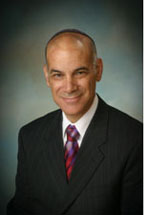 SAN DIEGO—One of the fundamental underpinnings of Kashrut is the ethical and humane treatment of animals. Animals are to be slaughtered quickly and with the least amount of pain possible. We don’t mix meat and milk to remind us of the pain potentially caused to animals when the Biblical injunction of cooking a kid in its mother’s milk is violated. SAN DIEGO—One of the fundamental underpinnings of Kashrut is the ethical and humane treatment of animals. Animals are to be slaughtered quickly and with the least amount of pain possible. We don’t mix meat and milk to remind us of the pain potentially caused to animals when the Biblical injunction of cooking a kid in its mother’s milk is violated.
The Conservative Movement recently initiated a program to insure that workers who work in Kosher meat processing plants are also treated humanely and justly. Companies that meet the designated standards are awarded a Heksher Tzedek (Certification of Righteousness) which certifies that the company provides a safe and appropriate working environment for its employees.
Almost half of America’s Kosher meat and poultry comes from a company called "Agriprocessors." Much of the Kosher meat that Agriprocessors produces is sold under several trade names, among them: "Rubashkin’s," "Aaron’s Best" and "David’s." Rubashkin’s meat is sold at most of San Diego’s Kosher markets. The Aaron’s Best and David’s labels, until recently, were found at Trader Joe’s.
The Conservative Movement’s Heksher Tzedek Commission has conducted site visits to AgriProcessors’ plant in Postville, Iowa and found many problems relating to worker health and safety. The company has been cited numerous times by the U.S. government for health and safety violations. On May 12th the largest immigration raid in U.S. history was conducted at the plant. 389 people were arrested. 297 pleaded guilty and were deported.
The United Synagogue of Conservative Judaism and the Rabbinical Assembly are asking their constituents to evaluate whether or not they should be using Agriprocessors’ meat and poultry until the problems are resolved. This advisory includes public (such as at weddings and Bar/Bat Mitzvah receptions) as well as private consumption. In San Diego this is a particular problem since most of our Kosher meat bears the Rubashkin’s label.
Until Agriprocessors is cleared by our Heksher Tzedek Commission those of us who keep Kosher should steer clear of all Rubashkin’s products, and ask our suppliers to secure their meat from other sources. (Trader Joe’s has already switched to Empire poultry.) We must insist processors of Kosher meat and poultry treat their workers, as well as their animals, humanely and ethically.
Please click here for more information on the Conservative Movement’s Heksher Tzedek.
.

.

AMAZING STORIES OF JUDAISM
The importance of a Hebrew name
By Rabbi Baruch Lederman
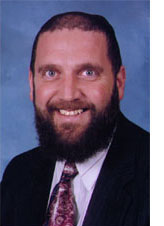 SAN DIEGO—And Moses called Hoshea (son of Nun) "Joshua", Yehoshua (Numbers, Ch. 13, V. 16). SAN DIEGO—And Moses called Hoshea (son of Nun) "Joshua", Yehoshua (Numbers, Ch. 13, V. 16).
David & Sarah Fried were devastated when they learned that their new baby woud be born with the dreaded disorder known as spina bifida. Children born with spina bifida usually require an operation shortly after birth which drains accumulated fluid near the brain.
The surgery delayed the bris of their son, but it also gave the young parents more time to reflect on the choice of a name for this speical child (boys are given their Jewish names at the bris). The Steipler Gaon, Rabbi Y.Y. Kanievsky (1899-1985) said that a boy with this condition should be given a name such as Baruch meaning blessed, which is an expression of both prayer and hope for his welfare.
They were reluctant to give this name since they already had a daughter named Bracha which is similar to Baruch; but Rabbi Shmuel Kamenetsky (Philadelphia) advised them that it was proper to do so despite the similarity in names.
The next week though was the Torah portion of Shelach. David saw a commentary of Rabbi Shamshon Refael Hirsch explaining that when Moses dispatched the men to spy out the land of Israel, he changed the name of Hoshea to Yehoshua (Joshua), as a prayer that the spies be safe and secure in their mission. Yehoshua would be a guiding light to his companions "not to lose sight" of their mission.
The idea of Yehoshua setting an example struck David. Yes, he would name the child Yehoshua and he and his wife would strive to make their child so happy that he would be a positive influence on anyone beset by handicaps. Sarah agreed immediately. The baby progressed to where the bris could finally be scheduled.
The night before the bris, David's father called and asked, "Have you decided on a name?" David avoided giving a direct answer. His father persisted, "If Sarah doesn't have a particular relative whom she is obligated to name after, then I want you to name him after my brother Bernie who passed away a few months ago. No one has been named for him." His father was emphatic.
David didn't know what to say. He had liked and respected his uncle but the other name meant so much to them. Still, he wanted to avoid a confrontation with his father. "What was Uncle Bernie's name?" David asked reluctantly. "Yehoshua Baruch!" came the startling reply. [The foregoing true story is documented in Along the Maggid's Journey.]
Dedicated by Ivor & Joan Jacobson in memory of their daughter Lauren.


ADVENTURES IN SAN DIEGO JEWISH HISTORY
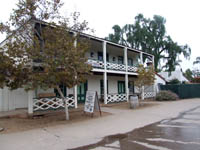
Robinson-Rose House
|
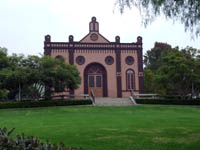
Old Temple Beth Israel |
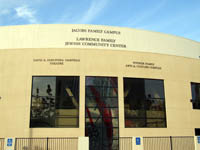
Lawrence Family JCC |
Editor's Note: We are reprinting news articles that appeared in back issues of various San Diego Jewish newspapers. You may access an index of the headlines of those articles by clicking here. You may also use the Google search program on our home page or on the headline index page to search for keywords or names.
'And A Little Child Shall Lead Them’
From Southwestern Jewish Press, April 24, 1947, page 3
Children are doing their part in the 1947 United Jewish Fund Campaign. Little Nadene Feller, about 10 years old, came to the office of the United Jewish Fund and asked if she might make a contribution. She filled out a pledge blank for $5.00 and left a dollar in nickels and dimes which she had saved by giving up the things she wanted most.
Linda Douglas, 9 years old, who gave up her ice cream bars in order to make a $5.00 subscription to the United Jewish Fund so that she might help children overseas sent $5.00 in nickels and dimes to the Fund as payment.
The Eber children, Sarah Jane and Alan saved $10.00 to buy their mother a birthday present. They heard their mother and dad talking about the needs of children in Europe and they figured that those children needed it more than their mother. They also felt that it would make a very good birthday present for their mother, so they gave $10.—to the United Jewish Fund. And little children are leading in San Diego.
Beth Jacob Congregation
From Southwestern Jewish Press, April 24, 1947, page 4
At the last joint meeting of the Boards of the Congregations, the Ladies Auxiliary and the P.T.A. of the Religious School it was decided that formal installation of the Beth Jacob Congregation’s new spiritual leader, Rabbi Abraham L. Rosenbloom, would be held at a banquet to be given Sunday, June 1st, in the Beth Jacob Center, 3206 Myrtle Street. Many out of town guests as well as local leaders will be invited to attend.
Mr. and Mrs. Charles Press, officers and leaders in the congregation are donating the cost of the dinner so that all monies charged the guests will go to the benefit of the Shule.
A gigantic membership campaign has been launched and the committee working have pledged to secure 100 new members to present to Rabbi Rosenblum at his installation.
S.O.S. Still Needs Your Support
From Southwestern Jewish Press, April 24, 1947, page 4
By Ida Nasatir
Chairman
The S.O.S. collection is in dire need of food and clothing . San Diegans are reminded that the drive is a continuing project of the Joint Distribution Committee with 16 national Jewish women’s organizations and other groups. The Douglas Tire Co. which houses local contributions until a sufficient shipping amount is received is ready to take your contributions. Continuous pleas and letters from national headquarters stress the unparalleled need for baby layettes and clothing, for tinned food, medical supplies, for toys and comfort necessities.
Go through your wardrobe today; bring your clean, good, used clothing to the Douglas Tire Co., at 1046 Market St. And some tinned food and a tiny garment fo some infant who begs you to dress him and her. Can you say, “no?”
S.D. To Have Summer Camps
From Southwestern Jewish Press, April 24, 1947, page 4
The Community Center Planning Committee, appointed by the United Jewish Fund to investigate the needs for a Jewish Community Center and to make whatever plans are necessary, will sponsor a 5 week home camp for children, from the age of 6 to 14 as the first step in a group work program for Jewish children in San Diego. The program will be under the supervision of trained personnel, directed by Albert A. Hutler.
The home camp will open on Monday, June 23 and will run through July 25th. It will operate on a 5 day a week schedule from 9:30 a.m. to 3:30 p.m. Present plans call for the children to meet at the Temple center and from there to follow a set program under the direction of counselors. The program will center around group activities designed to bring out the most creative abilities in each of the children and to give the children an opportunity for group living. Among the activities planned will be sports, swimming, dancing, music, camp ore, storytelling, hiking, horseback riding, arts and crafts and many other activities. There will also be trips to points of interest in and around San Diego County.
Each child will bring his own box lunch. Parents will receive a recommended bill of fare for luncheon but the home camp will provide each child with milk and cookies.
Arrangements have been made with the City County Camp Committee for the use of camp Palomar in the Palomar Mountains for one weeks starting July 28. This camp will be for boys ranging from the ages of 8 to 15 who will be able to spend one week away from home under trained camp leadership.
It is expected that the fee for the 5 weeks of home camp will not exceed $50.00 or approximately $10.00 per week including milk, cookies and transportation. The fee for the week at Camp Palomar, including transportation, will not exceed $25.00. Registrations will be limited so it is suggested that those interested in pre-registering their children, immediately contact Albert A. Hutler, 609 First National Building, Franklin 0171. The date for registration will be announced in the very near future.
{Return to top}


SAN DIEGO JEWISH WORLD THE WEEK IN REVIEW
Middle East
Costs, benefits to Hamas regularization by Eran Lerman in Jerusalem
Wars among the Jews heat up in Israel by Ira Sharkansky in Jerusalem
U.S. and Israel prefer stability among Arab nations rather than real democracy by Shoshana Bryen in Washington, D.C.
San Diego
UJF backs programs to transport local seniors, build school in Sha'ar Hanegev by Donald H. Harrison in San Diego
Jackie Gmach receives Marla Bennett Humanitarian Award from AFMDA by Yvonne Greenberg and Paul Greenberg in La Jolla, California
Adventures in San Diego Jewish History
—April 10, 1947: Organizations 'working with' UJF
—April 10, 1947: USO-JWB Activities
—April 24, 1947: San Diego Sends $50,000 From Emergency Fund To Aid European Jews
The Arts
Chapter Thirteen of Reluctant Martyr, a serialized novel by Sheila Orysiek of San Diego
)Middle East
Skepticism over Israel-Hamas ceasefire by Ira Sharkansky in Jerusalem
Canada
Jews and Canada's First Nations have much to learn from each other's experiences by Rabbi Dow Marmur in Toronto
Adventures in San Diego Jewish History
—April 10, 1947: Prof. Sheldon Warns of Bundist revival
—April 10, 1947: We Were There by Albert Hutler
—April 10, 1947: Eminent Speakers to Appear in San Diego This Week
The Arts
Thursdays with the music of Hal Wingard
—#14 The Dog, The Cat And Me
—#153 Have You Hugged Your Cat Lately?
—#278 Boasting
Lifestyles
Have you ever tried making 'old' friends? by Donald H. Harrison in San Diego
Middle East
Hamas will rebuild during the ceasefire by Shoshana Bryen in Washington D.C.
San Diego County
Russert's death prompts walking regimen by Donald H. Harrison in El Cajon, California
San Diego Jewish Trivia: Journalists by Evelyn Kooperman
Adventures in San Diego Jewish History
—March 20, 1947: UJF Youth Division Organizes
—March 20, 1947: Sergeant Inspires Youth Division
—March 20, 1947:‘Personality’ Talk Impresses TYL
Arts
—L'il Noodle, a kid who'll steal your heart by Cynthia Citron in Los Angeles
United States of America
Jews are Obama’s base, not his problem by J. Zel Lurie in Delray Beach, Florida
San Diego
Orthodoxy and sports juxtaposed at gala by Donald H. Harrison in San Diego
Obituary: Isadore Horne, Holocaust survivor, 92 by Donald H. Harrison in San Diego
The Arts
The Jewish history of the Incredible Hulk by Rabbi Simcha Weinstein in New York
Adventures in San Diego Jewish History
—March 20, 1947: Pioneer Women
—March 20, 1947:Appeal for Seder Home Hospitality for Servicemen
—March 20, 1947:B’nai B’rith Presents Wheel Chairs to Hospital
—March 20, 1947:Carl Esenoff to Head Jewish Welfare Society
|
|
